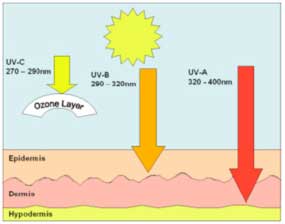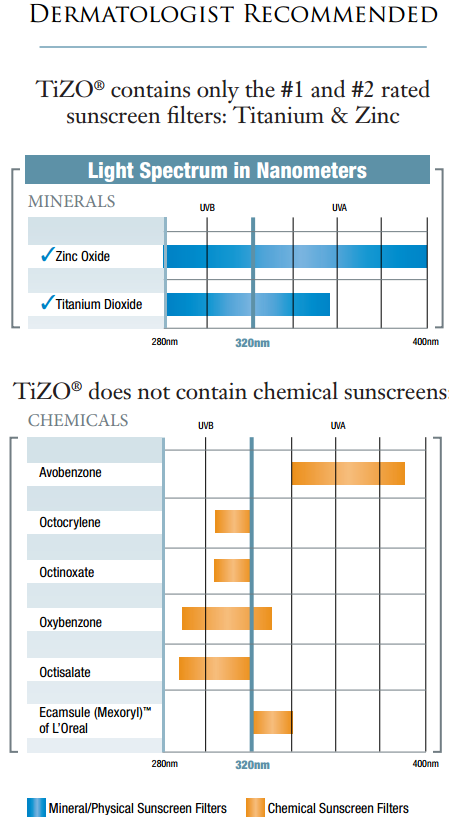Importance of Zinc Oxide in the sunscreen and the difference between UVB and UVA rays.

UVB radiation penetrates the epidermis or outer layer of the skin. It damages DNA in this layer and causes other changes in skin cells. This ultimately may result in the signs of photoaging. Over time, precancers and skin cancers may develop. UVB rays are active in the spring and summer months that cause the sun burn.
UVA radiation, while also damaging the epidermis, penetrates deeper into the skin to the level of the dermis, releasing free radicals, depleting skin of protective antioxidants and causing DNA changes. UVA rays not only harms epidermal cells, they also damage collagen and elastin, which make up the structure of the dermis and keep the skin resilient. Blood vessels can also be harmed. UVA rays and the aging process are intertwined. It is the long ultraviolet rays (UV-AI) that are responsible for photoaging, including wrinkles, dark blotches, pigmentation, freckles, a leathery texture, and loss of elasticity. UVA rays are 30- to 50-times more prevalent than UVB rays. Studies demonstrate that it takes relatively small amounts of repeated UVA exposure to cause photoaging in human skin; only 9 moderate doses of UVA radiation are necessary before changes in the skin are evident. It is now known that UVA radiation does induce mutations in DNA, leading to skin cancers in both animal and human skin. UVA rays are invisible rays that are active throughout the entire year and can penetrate through the clouds and the windows! Also, for the most part, tanning beds utilize in most part UVA rays, which increase the risk of melanoma, the deadliest form of skin cancer.
As you can see in the picture on the right side, UVB rays have a shorter wavelength (290-320 nm) penetrating just the epidermis, versus UVA rays, which have a much longer wavelength (320-400nm), penetrating both the epidermis and dermis. This is an important fact which will help you understand which sunscreens provide the entire broad spectrum protection, up to 400nm.
The picture on the right side lists common sunscreens and how much protection they provide. The blue color indicates physical blockers and orange indicates chemical sunscreens. As you can see, Zinc Oxide is the only ingredient that provides the entire broad spectrum protection, up to 400nm. Titanium Dioxide is also a good physical blocker but it only provides protection against UV rays approximately up to 350nm. None of the chemical sunscreens (marked in orange color) provide up to 400nm UV protection. Remember that whenever you are outdoors, you are always exposed to UVA rays, even in the winter months and on rainy day, those rays also penetrate through windows, even while driving!
How much skin aging is due to photo versus normal aging? On sun exposed skin, up to 90% of skin aging is due to the damaging effects of the sun. Compare the skin on an area rarely exposed to the sun with that on the face to see the difference in tone, color and texture. The natural aging process is dependent on time and genetics, and is unchangeable. However, photoaging can be avoided with good sun protection habits. Sun damage doesn’t occur over night; it has a cumulative effect, thus daily sun protection is critical.
I am very excited to introduce TiZo Physical Sunscreen which I discovered at the Skincare Conference. It uses 100% physical (mineral) sunscreen ingredients. The United States EPA has ranked the sunscreen ingredients used in TiZO as #1 and #2 for UVA-UVB protection (Zinc Oxide and Titanium Dioxide). TiZO minerals are purified to Pharmaceutical-grade and sit invisibly on top of the skin and are not absorbed, which dramatically decreases the possibility of skin irritation. Many competitive sunscreens contain up to five (chemical) sunscreen ingredients, which may cause skin irritation and feel oily and greasy.

